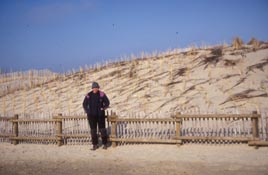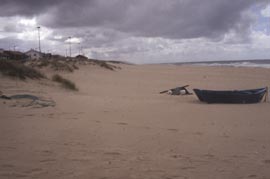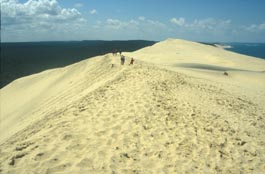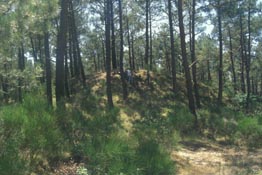The Leverhulme Trust Research Fellowship:
North Atlantic Oscillation impacts on sand drift
Abstract
Variations in the state
and intensity of the North Atlantic Oscillation (NAO) control the
location and strength of westerly storm tracks moving across the
Atlantic and into Europe. In historic
times, persistent and intense storminess affecting western European
coasts
caused periods of sand invasion resulting in village abandonment and
problems
for agriculture. This research seeks to apply absolute dating methods
to
coastal dunes in Portugal and France to resolve past episodes of sand
invasion
in order to establish a record of changes in the state of the North
Atlantic
Oscillation over the last 10,000 years.


Figure 1. North Atlantic Oscillation: (a)
NAO+ enhanced westerlies bring rain (dashed shading) to the Britain and
Scandanavia, while enhaced tradewinds drive Saharan dust plumes across
the Atlantic to the Caribbean; (b) NAO- reduced strength westeries and
tradewinds, rain (dashed shading) over the Iberian Peninsula and
western Mediterranean.[from Clarke & Rendell, 2006]
Historical records of the
NAO derive from archive sources, instrumental data (Luterbacher et al.,
2002) and tree-rings (Glueck & Stockton, 2001) and span the period
from the present back to 1429 years AD. At present, little is known
about the state of the NAO prior to this time period. Given the
sensitivity of coastal dunes to changes in location of westerly storm
tracks, these dunes provide an aeolian sedimentary record of NAO
status. Beyond the historical period, dunes in France were emplaced
3.3-3.6ka (Clarke et al., 2003) and Portugal 1.4ka, 2.2ka, 8.2 and
9.1ka
(Clarke & Rendell, 2006). Given the apparent sensitivity of coastal
dunefields
to Atlantic storminess, a systematic and detailed sampling and dating
programme
can provide unique insights into the state and dominance of the NAO
during
the Holocene period. This research aims to use optically-stimulated
luminescence
(OSL), in comparison with radiocarbon (14C) techniques,
where
applicable, to determine (a) the timing of Holocene sand drift and dune
building episodes and (b) periods of land surface stability associated
with
soil development, in order to provide a regional chronology for
Atlantic storminess and dune building. Comparison of chronologies
between sites will allow the persistence and intensity of the NAO to be
evaluated for this period
of Holocene. OSL techniques are applicable to aeolian sands and provide
a
date for the timing of sand grain burial within a dune or sand sheet
(Aitken, 1998) whereas 14C can be applied to carbon
extracted from peat or buried soils. The coastal fringes of both
Portugal and Aquitaine contain undated mid-early Holocene sands and
buried soils (Clarke et al., 2002; Clarke & Rendell, 2006). This
project seeks to exploit this sedimentary archive to better understand
Atlantic climate changes throughout the Holocene period.


Photographic diaries of fieldwork undertaken for this project are linked here: Portugal in July 2006 and France in January 2007.
Aitken, M.J. (1998) An Introduction to Optical Dating. Oxford University Press
Bond, G., Showers, W., Cheseby, M., Lotti, R., Almasi, P., deMenocal, P., Priore, P., Cullen, H., Hajdas, I. and Bonani, G. (1997) A pervasive millennial-scale cycle in North Atlantic Holocene and glacial climates. Science 278, 1257–66.
Clarke, M.L. & Rendell, H.M. (2006) The effects of storminess, sand supply and the North Atlantic Oscillation on sand invasion and coastal dune accretion in western Portugal. The Holocene, 16 (3), 341-355.
Clarke, M.L., Rendell, H.M., Tastet, J-P., Clavé, B. & Massé, L. (2002) Late Holocene sand invasion and North Atlantic storminess along the Aquitaine Coast, southwest France, The Holocene, 12, 231-238.
Dawson, A.G., Hickey, T., Holt, T., Elliot, L., Dawson, S., Foster, I.D.L., Wadhams, P., Jonsdottir, I., Wilkinson, J., McKenna, J., Davis, N.R., Smith, D.E. (2002) Complex North Atlantic Oscillation (NAO) Index signal of historic North Atlantic storm-track changes. The Holocene, 12, 363-369.
Glueck, M.F. & Stockton, G.W. (2001) Reconstruction of the North Atlantic Oscillation, 1429-1983. International Journal of Climatology, 21, 1453-1465.
Lamb, H.H. (1995) Climate, History and the Modern World. 2nd edition, Routledge, London.
Lamb, H.H. & Frydendahl, K. (1991) Historic Storms of the North Sea, British Isles and northwest Europe, Cambridge University Press.
Luterbacher, J., Xoplaki, E., Dietrich, D., Jones, P.D., Davies, T.D., Portis, D., Gonzalez-Rouco, J.F., von Storch, H., Gyalistras, D., Casty, C. and Wanner, H. (2002) Extending North Atlantic Oscillation reconstructions back to 1500. Atmospheric Science Letters 2, 114-124.
Wilson, P., McGourty, J & Bateman, M.D. (2005) Mid- to late-Holocene coastal dune event stratigraphy for the northeast coast of Northern Ireland. The Holocene, 14, 406-416.
